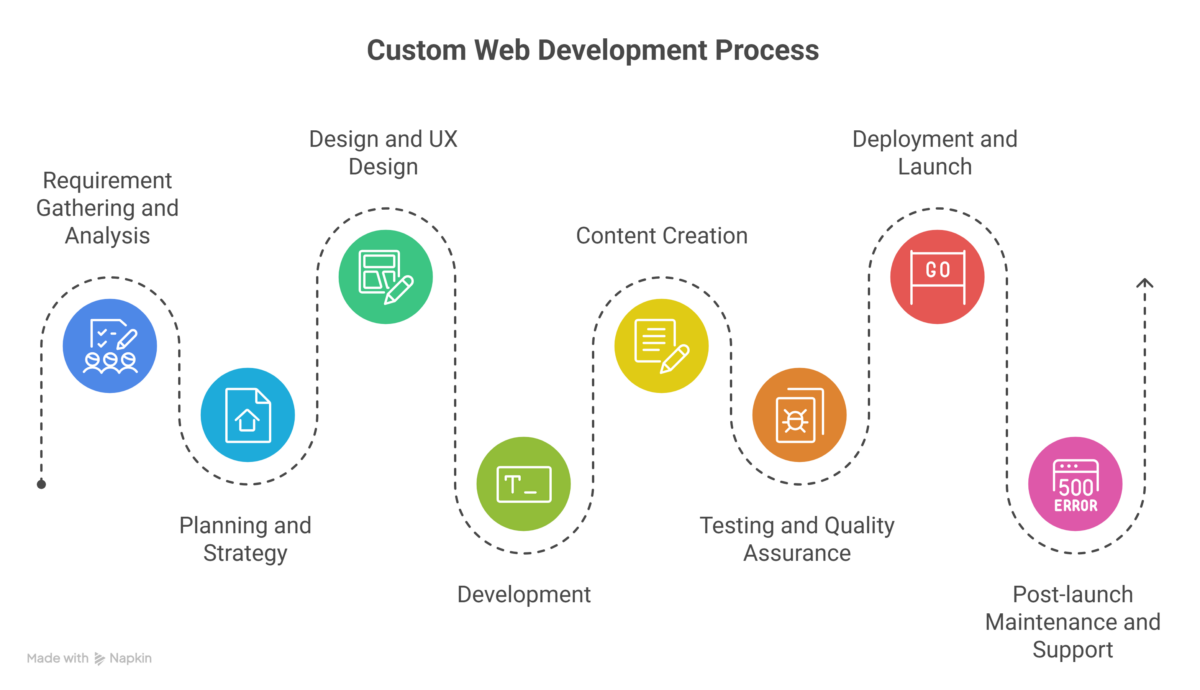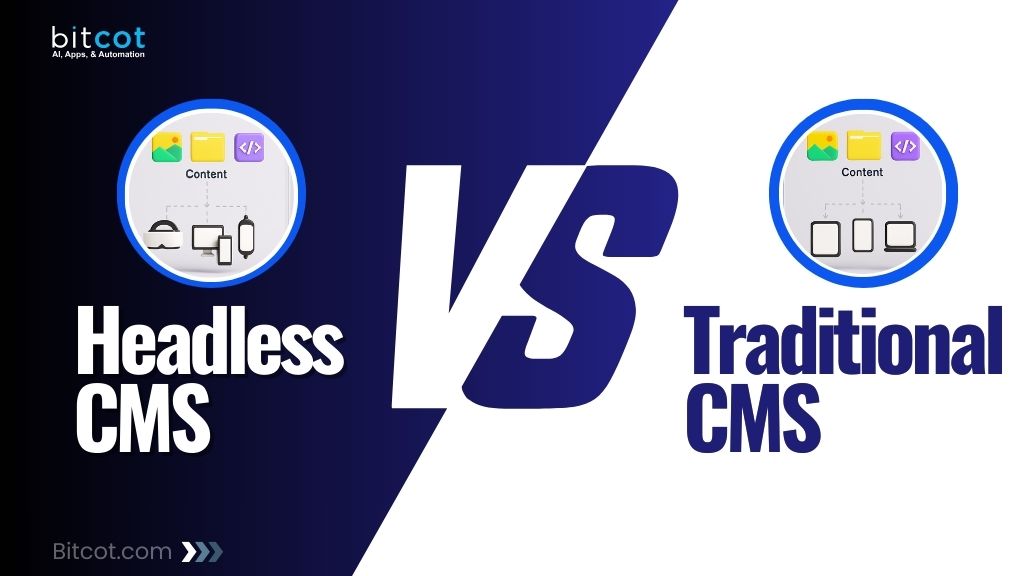
Your website is no longer just a digital brochure. It’s your most powerful sales tool, working 24/7 to grow your business.
But here’s the truth: generic templates won’t cut it in 2025’s competitive landscape where users expect personalized, lightning-fast experiences tailored to their needs.
With online marketing, your business needs a functional website to reach customers and promote growth. A tailored approach to building your site is the best way to establish an online presence for a company depending on their brand, services and business objectives.
We will take a look at the definition of custom website development in this comprehensive guide. Let’s compare the advantages of customized solutions vs ready-made templates or themes. Learn about all the services these sites offer in the realm of functionality, SEO, usability and conversion optimization.
Additionally, we’ll discuss how to identify whether this approach is the solution for you. Lastly, we’ll explore how a skilled developer can turn your vision into a successful website that delivers results.
Whether you are developing a new website or redesigning a site, this article will show you how to take advantage of tailored web solutions to maximize your investment. Let’s get started!
Custom Web Development History – Evolution from Then to Now!
The origins of bespoke website development trace back to the 1990s and early 2000s when the internet was still relatively new. Early on, most websites were built from scratch using languages like HTML, JavaScript, and CSS to create static sites with limited interactivity.
As the internet evolved, content management systems like WordPress and Drupal emerged to enable more dynamic websites. Development shifted towards fully customized themes and plugins to tailor the CMS platform to each client’s brand and needs.
In the 2010s, advanced JavaScript frameworks like Angular, React, and Vue.js took development further by enabling complex single-page applications. Developers could now build highly interactive web apps with slick UIs and real-time updates.
Today, modern web development is fueled by diverse technologies like Node.js, Python, .NET, and Ruby on Rails to deliver online experiences tailored to each client’s vision. Headless CMS platforms separate content from presentation for greater flexibility.
Key trends shaping modern development include:
- Lightning-fast performance with Core Web Vitals optimization
- Seamless mobile-first design for 60%+ mobile traffic
- AI and machine learning integrations for personalization
- Voice/conversational UIs and chatbot interfaces
- Edge computing for faster content delivery
- Component architecture and micro-frontends for efficient scaling
- Progressive Web Apps (PWAs) for app-like experiences
- Enhanced accessibility (WCAG 2.2 compliance) and security
- AI automation solutions for streamlined business processes
- Workflow automation integration for operational efficiency
The demand for custom-built websites continues to grow rapidly as businesses seek to differentiate themselves digitally and meet rising user expectations for interactivity, speed, and personalization in online experiences. With developers writing an estimated 600 billion lines of code projected for 2025, partnering with specialized agencies helps enterprises bring ambitious digital projects to life.
Also Read: Custom Web Application Development: Process, Cost, Timeline
Now that we’ve explored the evolution, let’s dive into what exactly this approach entails and how it differs from other website building methods.
What is Custom Web Development?

What does custom web development mean for my business? Custom website development is the process of designing and building a unique website specific to your business needs. Instead of using a premade template, a developer will work directly with you to create a bespoke website from scratch, allowing for complete customization and flexibility. This tailored approach focuses on delivering a website that aligns with the business’s branding, functionality, and user experience goals.
With a custom-built site, the developer has complete control over the site’s architecture, features, and design. This allows them to construct a site optimized for your goals, whether that be promoting your products, highlighting your services, generating leads, or driving sales.
The finished website will have the look, feel, features, and functionality that you want. Modern solutions also incorporate AI website builder technologies to accelerate development while maintaining customization capabilities.
On the technical side, bespoke solutions leverage programming languages like HTML, CSS, JavaScript, and backend languages to enable advanced interactive capabilities, seamless integrations, robust CMS-powered content editing, scalability, and tight security protocols. Experienced web developers also optimize sites for speed, accessibility, SEO, and omnichannel delivery across devices.
Also Read: Custom Ecommerce Development: Features, Benefits, Costs, Timeline
The end result is a tailored, high-value digital product that helps brands differentiate, effectively engage customers, and accomplish strategic business goals through their online presence. This is the transformative potential of custom solutions.
Understanding what this approach is sets the foundation, but why should businesses opt for tailored solutions over readily available alternatives? Let’s explore the compelling reasons.
Why Opt for Custom Website Development Solutions?
Why should I choose custom web development over templates? Custom website development solutions offer functionality and design that align with specific business needs. According to a recent survey by Clutch, 72% of businesses prefer custom solutions over off-the-shelf alternatives. These bespoke web solutions provide the flexibility to incorporate unique features that cater to target audiences and industry requirements. Professional web development services ensure a seamless user experience, improved brand representation, and enhanced customer engagement.
Insights emphasize the importance of responsive and mobile-friendly websites for reaching a broader audience. With mobile devices accounting for approximately 60-64% of global web traffic as of 2025, custom websites ensure optimal performance across various screen sizes and platforms. Additionally, customization allows businesses to incorporate the latest SEO practices, schema markup, and on-page optimization techniques, boosting visibility and search engine rankings.
Security is a critical concern for businesses operating online. The IBM Cost of a Data Breach Report 2025 states the global average cost of a data breach is $4.44 million (with U.S. companies experiencing costs of $10.22 million), making security a top priority. Tailored solutions allow businesses to implement robust security measures specific to their needs, such as encrypted data transmission, secure payment gateways, and advanced user authentication systems.
By investing in bespoke solutions, businesses can mitigate cyber risks and build trust with their customers.
While the benefits are clear, many business owners wonder how they compare to the convenience and lower upfront costs of website templates. Let’s break down this critical comparison.
Custom Web Development vs Website Templates
What’s the difference between custom websites and templates? When it comes to building a website, businesses have the option to choose between tailored development and using website templates. Each approach has its own set of advantages and considerations. In this section, we will compare the two to help you make an informed decision.

Here’s an overview of how the two options compare:
Custom Website Development
Building a site from scratch involves tailoring specifically to a business’s unique requirements and goals. Here are some key points to consider:
- 100% unique design and development
- Built for your specific business and goals
- Full control and ownership of the site code
- Advanced features and integrations (AI, IoT, edge computing)
- Optimized UX design for conversions
- Flexibility to meet current & future needs
- Higher upfront investment but long-term value
- Better performance optimization and Core Web Vitals scores
- Bespoke functionality tailored to business processes
Website Templates
Website templates are pre-designed website layouts that businesses can choose and customize to some extent. Here are some considerations regarding website templates:
- Pre-designed layouts and themes
- Limited customization options
- General one-size-fits-many approach
- Out-of-box functionality only
- Constrained UX design options
- Unable to add advanced features easily (AI integration, custom APIs)
- Lower upfront cost but limitations long-term
- May struggle with modern performance standards
- Generic design shared by multiple websites
As you can see, tailored development allows for an ideal website built for you, while templates provide a more cookie-cutter site. For most businesses seeking a website that stands out and achieves results, the investment in a bespoke solution is worthwhile.
Having established the advantages over templates, let’s examine the specific benefits that make this approach such a valuable investment for businesses.
Benefits of Custom Web Development Solutions

Tailored solutions offer a range of benefits for businesses looking to establish a solid online presence. Here are the potential benefits of investing in custom web development:
1. Enhanced Brand Identity and Unique Online Presence
A custom website perfectly aligns with your brand identity through unique visuals, colors, typography, and design elements, differentiating you from competitors and leaving a memorable impression. This bespoke approach ensures your website design reflects your company’s values and personality.
2. Scalability and Flexibility for Future Growth
This approach provides the flexibility to scale features, functionalities, and content as your business evolves, ensuring your site adapts to industry trends, customer demands, and tech advancements including AI integration, IoT connectivity, and edge computing capabilities. This scalable web architecture supports business growth without platform limitations.
3. Tailored User Experience for Improved Engagement
Building from scratch allows you to optimize the user interface and experience for your target audience, increasing engagement and conversions through an intuitive, seamless browsing experience. With 60%+ of users not returning to websites due to poor mobile experience, tailored development ensures responsive web design across all devices with optimized navigation and user flows.
4. Integration of Advanced Features and Functionality
This approach provides the freedom to integrate advanced features and functionalities specific to your business requirements, including:
- AI-powered chatbots and personalization engines
- Progressive Web App (PWA) capabilities
- IoT device integrations (with 30 billion IoT devices expected in 2025)
- Voice search optimization
- Real-time data processing and analytics
- Advanced API integrations
- Chatbot development for 24/7 customer support
- AI Development capabilities for intelligent automation
5. Enhanced Security and Data Protection
Bespoke solutions ensure tailored security measures. Implement advanced protocols, encryption, authentication systems, and regular updates to protect your website and user data. With data breach costs averaging $4.44 million globally and $10.22 million in the U.S., robust security is essential to build visitor trust and safeguard your reputation.
6. SEO-Friendly Structure and Optimization
Custom solutions boost SEO by creating an optimized website structure and clean code. By implementing proper site architecture, meta tags, schema markup, XML sitemaps, Core Web Vitals optimization, and other technical SEO best practices, you can enhance visibility, improve organic search rankings, and attract relevant traffic. Tailored sites offer better control over page speed optimization and mobile-first indexing requirements.
7. Long-Term Cost-Effectiveness
While this approach may require a higher upfront investment compared to ready-made templates, it offers long-term cost-effectiveness. Ready-made templates often come with recurring fees and limitations on customization, leading to additional costs in the long run.
8. Ongoing Support and Maintenance
Bespoke solutions provide ongoing support and maintenance, ensuring the website stays up-to-date, secure, and functioning optimally through regular updates, bug fixes, security patches, and technical support. This includes website maintenance services, performance monitoring, and continuous optimization.
With these compelling benefits in mind, one of the first questions business owners ask is about investment. Let’s explore the cost considerations for projects like these.
How Much Does It Cost to Develop a Custom Website?
How much should I budget for a custom website? For organizations undergoing a website rebuild or seeking an online presence, one of the first considerations is budget. Costs vary based on the complexity and exact scope, but some general ranges are:
Basic Website – $15,000 to $30,000
A simple 5-10 page informative website with minimal custom functionality, responsive design, and basic content management system.
Medium Website – $30,000 to $70,000
A more robust website with customized design, interactive features, contact forms, blogs, user logins, and light integrations with third-party services. This range typically includes UI & UX design services for optimal user experience.
Complex Website – $70,000 to $150,000+
A highly advanced website requiring heavy custom programming, databases, AI integrations, PWA capabilities, third-party API connections, high traffic loads, advanced security measures, and extensive features. Enterprise-level web applications fall into this category. This tier often includes Web app development services, eCommerce website development services, and enterprise website development solutions.
Cost Impacting Factors
Variables that influence project costs include:
- Number of page templates and overall site size
- Custom design and branding needs
- Interactive features like web applications, forms, blogs, etc.
- AI/ML integrations and advanced functionality
- Third-party integrations required (CRM, payment gateways, analytics platforms)
- Progressive Web App (PWA) implementation
- Content strategy, creation, and population
- Quality assurance and performance testing needs (Core Web Vitals optimization)
- Web hosting and infrastructure considerations
- Security measures and compliance requirements (GDPR, CCPA)
- Desired launch timeframe and development timeline
More complex requirements drive costs higher.
Typical Cost Allocation By Phase
In terms of percentage of budget allocated per phase:
| Phase | Avg. Cost Allocation |
| Strategy | 5-10% |
| Design | 15-20% |
| Front-End Dev | 25-35% |
| Back-End Dev | 20-30% |
| Testing | 15-20% |
| Launch | 5-10% |
Programming represents the bulk of expense.
Key Cost Considerations
When budgeting, consider additional factors like:
- Monthly hosting fees – $100-$500+ (depending on traffic and infrastructure)
- SSL certificates – $50-$200 per year
- Domain registrations – $15-$50 annually
- CDN services – $50-$300+ monthly
- Ongoing support & maintenance – 15-20% of total cost annually
- AI/ML service costs – Variable based on usage
- Future enhancements – Quoted based on needs
Adequate investment in core website foundations yields dividends over the long-term. But for advanced systems with AI integration, edge computing, and PWA capabilities, $100k+ is realistic for robust implementations.
Understanding the financial investment is crucial, but knowing the actual process of bringing a tailored website to life is equally important. Let’s walk through the key development phases.
What are the Main Steps in Custom Web Development?
Creating a custom website involves several key steps to ensure successful creation of a tailored site that meets the specific needs and requirements of a business. The main steps are as follows:
Step 1: Requirement Gathering and Analysis
This initial phase involves gathering detailed requirements from the client regarding their website goals, target audience, desired features, and functionality. It also includes conducting a thorough analysis of the business’s industry, competitors, and market trends to inform the development process. This phase now includes an assessment of AI integration needs, mobile-first requirements, and performance benchmarks.
Step 2: Planning and Strategy
In this phase, a comprehensive plan and strategy for the project are created. This includes defining the website’s structure, navigation, content architecture, and technology stack. Project timelines, milestones, and resource allocation are also determined during this stage. Modern planning includes Core Web Vitals targets, progressive enhancement strategies, and accessibility compliance planning.
Step 3: Design and User Experience (UX) Design
The design phase focuses on creating the visual elements and user interface (UI) of the website. Web designers work closely with clients to develop wireframes, mockups, and prototypes to ensure the website’s aesthetics and user experience align with the client’s brand identity and goals. Mobile-first design principles are prioritized given that 60%+ of traffic comes from mobile devices. This phase also includes UI/UX optimization, information architecture, and interaction design.
Step 4: Development
Once the design is approved, the development process begins. Web developers write the code and build the website’s functionality based on the requirements and design specifications. This includes front-end development (HTML, CSS, JavaScript frameworks like React, Vue.js) for the user interface and back-end development (server-side scripting, database integration, API development) for data processing and dynamic functionality. Modern development incorporates performance optimization, lazy loading, code splitting, and progressive web app capabilities to ensure fast, efficient websites.
Step 5: Content Creation
During this stage, content such as text, images, videos, and other media elements are created and optimized for the website. Content management systems (CMS) may be integrated to facilitate easy content updates and management. Content is optimized for voice search, featured snippets, semantic SEO, and user engagement. This includes copywriting, multimedia production, and content strategy implementation.
Step 6: Testing and Quality Assurance
Rigorous testing is conducted to identify and fix any bugs, errors, or compatibility issues. This includes functionality testing, performance testing (Core Web Vitals, page speed), cross-browser testing, responsive design testing across devices, accessibility testing (WCAG 2.2 compliance), security vulnerability assessments, and user acceptance testing to ensure the website functions smoothly across different devices and browsers. Quality assurance includes load testing, usability testing, and regression testing.
Step 7: Deployment and Launch
Once the website is thoroughly tested and approved, it is deployed to a live server or hosting environment. This involves transferring all the necessary files, setting up the database and server configurations, implementing CDN for faster content delivery, configuring security measures (SSL certificates, firewalls), and optimizing server performance. The website is then made publicly accessible with proper domain configuration and DNS setup.
Step 8: Post-launch Maintenance and Support
After the website is launched, ongoing maintenance and support are essential to ensure its optimal performance and security. This includes regular updates, bug fixes, security patches, performance monitoring, Core Web Vitals optimization, and technical support to address any issues that may arise. Continuous improvement based on analytics and user feedback is crucial.
It’s important to note that the process may vary depending on the specific project requirements and the development team’s approach. Effective communication and collaboration between the client and the development team throughout these steps are crucial for the successful completion of a custom website.
Now that you understand what this approach involves and how it’s built, the next logical question is: how do you know if it’s the right choice for your specific business needs?
How Do You Know If Custom Development is Right For You?
Is custom web development right for my business? Many businesses rely on simple website builders or templates for creating their online presence. But for some organizations, investing in a tailored solution can be the better strategic choice. Here are signs your business could benefit from bespoke services:
If any of the following apply to your business, a custom approach may be the right choice:
- Your brand, products, services, and target audience have unique needs not met by off-the-shelf templates.
- You want advanced functionality like AI-powered chatbots, custom databases, member areas, complex forms, IoT integrations, and specialty API connections.
- Your business model is expanding or evolving, requiring scalable solutions that can handle increased traffic and new features.
- You want complete control and ownership over your site’s design, content, UX, and features.
- Excellent SEO performance, Core Web Vitals scores, and conversion optimization are crucial to your online success.
- You need Progressive Web App (PWA) capabilities for app-like user experiences.
- You are undertaking a website redesign to better align with your current business goals and audience.
- Your website content, messaging, and design need to differentiate you from competitors in a crowded market.
- You have specific KPIs and ROI goals your website must achieve, requiring customization and advanced analytics.
- You need to integrate AI/ML capabilities for personalization, recommendations, or predictive analytics.
- Your site must handle high traffic volumes and require edge computing for faster global performance.
- Support long-term growth beyond your site’s initial launch and requirements.
If these factors align with your business needs, the benefits of this approach likely outweigh using an inflexible template.
Having identified whether this approach suits your needs, it’s important to understand why it has become the strategic choice for so many successful businesses.
Why Custom Website Development is the Right Approach for Many Businesses

What makes this better than using templates? For most businesses seeking more than an essential online presence, custom web development is the right strategic approach. Here’s why:
Total Brand Integration – Tailored solutions allow for seamless integration of your branding throughout the website’s design, content, imagery, fonts, colors, messaging, and more. This creates a consistent brand experience across channels, which is difficult to achieve with templates. Every element can be customized to reinforce your brand identity and values.
Conversion Optimization – With custom-built sites, conversion rate optimization (CRO) practices can be incorporated from day one. The layout, calls-to-action, copy, user flow, landing pages, and features are tailored to guide visitors to convert based on behavioral analytics and A/B testing strategies. This data-driven approach maximizes ROI.
Audience-Focused Design – Bespoke design based on research of your target audience allows you to craft experiences aligned with their preferences and motivations. With mobile users accounting for 60%+ of traffic, this approach ensures optimal mobile-first experiences. Pre-made templates cannot accommodate specific user needs.
Scalability and Flexibility – Properly planned websites are built on frameworks designed for easy scalability. As your business grows, you can readily add capabilities, pages, AI integrations, API connections, and features. Modern architectures support micro-frontends and component-based development for efficient scaling.
Ownership and Control – With full ownership of your site, you have complete control over changes and updates whenever needed. Templates often limit revisions and may lock you into proprietary platforms.
Performance and Speed – Experienced developers optimize code, loading times, hosting, CDN implementation, and site architecture to maximize performance and meet Core Web Vitals standards. With edge computing becoming standard, tailored sites can deliver content 75% faster by processing data closer to users. This isn’t easy to fine-tune with templates.
Search Engine Optimization – Custom code, metadata, URLs, page layouts, structured data markup, and technical SEO elements can all be optimized to improve SEO results – a key advantage over template limitations. These sites can better implement voice search optimization, semantic SEO strategies, and local SEO tactics for improved organic visibility and higher search rankings.
Advanced Technology Integration – Bespoke development enables integration of cutting-edge technologies like AI/ML for personalization, IoT connectivity for smart devices, Progressive Web App capabilities, chatbots, real-time data processing, and advanced analytics platforms that templates simply cannot support. This future-ready approach ensures your website leverages the latest web technologies.
Future Proof Investment – Well-executed custom websites remain relevant and high-performing for years after launch. They are engineered to adapt to emerging technologies like AI advancements, new web standards, and evolving user expectations. With 38% of developers prioritizing web development skills, the ecosystem continues to evolve rapidly.
Also Read: Custom WordPress Website Development and Design in 2025
With this approach, you are investing in an adaptable digital foundation designed to grow with your business and achieve your online goals both now and in the future.
Understanding the strategic advantages is one thing, but partnering with the right team to execute your vision is what turns strategy into success. Here’s how Bitcot can be your trusted development partner.
How Bitcot Can Help With Your Custom Website Development
If you determine that a custom solution is the right strategic choice for your business, partnering with the right digital agency is vital to executing a high-impact website.

Bitcot is a leading web development company that can assist businesses in their journey toward creating a tailored and successful online presence. Here’s how Bitcot can help:
Deep Process Understanding – We take the time upfront to thoroughly understand your business goals, target audience, content strategy, technical needs, and long-term vision. This insight informs the tailored solution.
Creative Conceptualization – Our talented team brainstorms creative directions for your brand messaging, visuals, and user experience flow to bring your vision to life with modern design trends and interactive elements.
Proven Development Expertise – With years of experience creating highly functional websites, our developers build flexible solutions using modern best practices, including React, Vue.js, Node.js, and cutting-edge frameworks. Our full-stack developers ensure robust, scalable architecture.
AI and Advanced Technology Integration – We implement AI-powered features like chatbots, personalization engines, predictive analytics, and machine learning capabilities to enhance user experiences and business outcomes.
Conversion Optimization – We weave conversion rate optimization principles into the site architecture, layout, copy, calls-to-action, and UX design from the start, backed by data-driven insights.
Performance Engineering – We build high-speed site backends with optimized databases, caching strategies, CDN integration, edge computing implementation, and cloud infrastructure scaled for traffic surges while meeting Core Web Vitals standards. Our performance optimization ensures fast page load times and excellent user experience.
Responsiveness and Accessibility – Your site will adapt seamlessly across mobile, tablet, and desktop with mobile-first design principles. We ensure WCAG 2.2 accessibility compliance for all users, inclusive design, and cross-browser compatibility.
Security Implementation – We implement robust security measures including SSL certificates, secure authentication systems, encrypted data transmission, and regular security audits to protect against breaches.
Ongoing Support and Maintenance – After launch, we provide ongoing support, troubleshooting, and maintenance to keep your site optimized.
Regular Updates and Fixes – We continually make updates to improve functionality, fix bugs, enhance integrations, and implement new features as technologies evolve.
Technical Support – Our IT support team is available to diagnose and resolve any technical issues that may arise quickly, ensuring minimal downtime.
Wrap Up!
Custom web development offers businesses the opportunity to create a unique and tailored online presence that aligns with their brand identity, goals, and customer expectations. With emerging trends like AI integration, edge computing, Progressive Web Apps, and the continued dominance of mobile traffic (60%+ of global web usage), this approach ensures your website stays competitive and future-ready.
The landscape of web development continues to evolve rapidly, with developers projected to write 600 billion lines of code in 2025. Bespoke websites provide the flexibility to adopt new technologies, optimize for performance (Core Web Vitals), implement advanced security measures (protecting against the average $4.44 million cost of data breaches), and scale as your business grows.
With the expertise of Bitcot, businesses can embark on a successful journey, leveraging the benefits of a tailored website to drive growth, differentiation, and success in the digital landscape.
We hope this guide provided valuable insights into the power of custom solutions for taking your digital presence to the next level. Ready to get started? Let’s schedule a free consultation to discuss your goals and how Bitcot can help achieve them through a custom-designed website optimized for 2025 and beyond.














